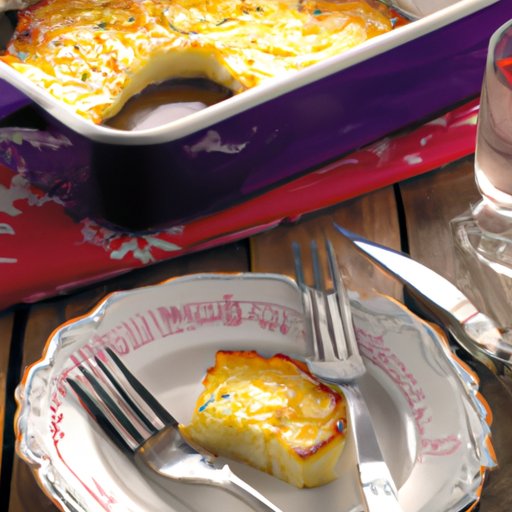The Ultimate Guide to Making Scalloped Potatoes: Step-by-Step Recipe, Historical Context, Regional Varieties, Nutritional Benefits, and Tips for Success
Scalloped potatoes are a beloved comfort food, which has been a staple dish in many households for generations. This dish is incredibly versatile, easy to make, and perfect for family gatherings, potlucks, and special occasions. In this article, we will take a closer look at this delicious dish, including its historical context, regional variations, and nutritional benefits. We will also provide a comprehensive step-by-step recipe, along with some expert tips and tricks to help you achieve the perfect dish every time.
Step-by-Step Recipe
The following ingredients make about 6-8 servings of scalloped potatoes:
- 6 potatoes, peeled and sliced thinly
- 1 onion, sliced thinly
- 3 tablespoons of butter
- 3 tablespoons of all-purpose flour
- 2 cups of milk
- 1 teaspoon of salt
- 1/2 teaspoon of black pepper
- 1/4 teaspoon of garlic powder
- 1/4 teaspoon of nutmeg
- 1 cup of grated cheese (optional)
Instructions:
- Preheat your oven to 350°F (175°C).
- Grease a 9×13-inch baking dish and set it aside.
- In a saucepan, melt butter on medium heat.
- Add flour, salt, black pepper, garlic powder, and nutmeg to the melted butter and whisk until it forms a smooth paste.
- Slowly pour milk into the saucepan, while stirring constantly to avoid lumps.
- Cook the mixture until it begins to thicken, which should take about 5 minutes. Stir it occasionally.
- Take the saucepan off the heat and set it aside.
- Slice the potatoes and onion thinly using a sharp knife or a mandolin.
- Layer the sliced potatoes and onion in the baking dish, alternating between the two.
- Pour the sauce over the top of the layered potatoes and onions.
- If you would like, you can add grated cheese over the top of the sauce.
- Cover the dish with foil and put it in the oven.
- Bake for about 45-50 minutes, removing the foil for the last 10 minutes to allow the top to get brown and crispy.
- Once the scalloped potatoes are ready, remove them from the oven and let them rest for 5 minutes before serving.
Historical Context
Scalloped potatoes originated in France in the 18th century, otherwise known as Gratin Dauphinois. The dish was named after the Dauphine region in France. The original recipe consisted of potatoes, milk, and butter, and the dish was traditionally served as a side dish with roasted chicken or beef. The dish became popular in North America in the 19th century and was modified over the years by adding cheese, onions, and other ingredients. Today, it is considered a classic comfort food, enjoyed by many around the world.
Regional Varieties
Scalloped potatoes vary depending on the region and culture that prepares them. In Germany and Austria, the dish is known as Kartoffelgratin and may include bacon, leeks, or Gruyere cheese. In the United States, the dish may be made with ham or other meats, as well as various types of cheese such as Cheddar or Parmesan. Scandinavia has its own version known as Janssons Frestelse, which is made with cream and anchovies. In Ireland, the potatoes are boiled and then sliced before being layered with cream and herbs.
Nutritional Benefits
Scalloped potatoes are not the healthiest dish due to its significant reliance on milk, cream, and cheese. However, the dish does have some nutritional benefits. Potatoes are a rich source of fiber, vitamins B and C, and minerals such as potassium and phosphorus. When consumed in moderation, scalloped potatoes can make a great addition to a balanced diet. By making some simple modifications such as using low-fat milk or cheese, and avoiding adding additional oil or butter, you can transform the dish into a healthier version without sacrificing its traditional flavor.
Tips and Tricks for Success
If you would like to elevate your scalloped potato game, here are some tips and tricks to help you achieve the perfect dish every time:
- Choose the right type of potato. Yukon Gold or Russet potatoes work well for scalloped potatoes because of their high starch content. They tend to hold their shape better and have a creamier texture.
- Make sure your potato slices are thin and even. Unevenly sliced potatoes will cook unevenly and may result in an undercooked or overcooked dish.
- Boil the potatoes for a few minutes before baking. Parboiling the potatoes before layering them in the baking dish will help to ensure that they are cooked evenly and prevent undercooked potatoes.
- Use the right amount of milk and flour to make your sauce. Too little flour will create a thin watery sauce, while too much can lead to a clumpy, heavy-textured sauce.
- Experiment with additional ingredients such as bacon, ham, or vegetables to enhance the flavor of your dish.
Conclusion
Scalloped potatoes are easy to make, delicious, and perfect for any occasion. With the tips and information provided in this article, you can become a scalloped potato aficionado in no time! With a little experimentation and imagination, you can make your version of this classic dish and impress your friends and family.
